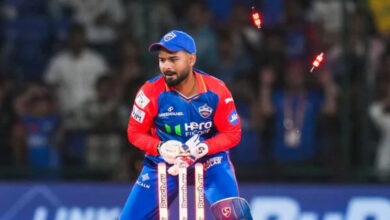With options running out, Rohit Sharma turned to old mate Shardul Thakur for breakthrough

At the halfway stage of New Zealand’s pursuit of 385 runs, Rohit Sharma scanned for bowling options. His preferred middle-over choice Yuzvendra Chahal had been just hit for 15 runs; Kuldeep Yadav had bowled five; Washington Sundar was a defensive option, with New Zealand at 184, he required wickets; Hardik’s six remaining overs should be preserved for the death overs. He turned his eyes to Shardul Thakur, stationed at fine-leg.
When Rohit signalled him to bowl, Thakur was slightly bemused. It’s not usually the time he bowls, his three overs had bled 30 runs. But Thakur is not someone to shirk away from a challenge. In his teenage days back in Palghar, he always used to challenge his seniors at the maidan to get the better of him. Often, he would succeed. His coach Siddhesh Lad had once told this paper: “He is the guy who will raise his hand when the situation is tough. He is the guy in the dressing room who will talk about taking on any batsman in the world. Such things motivate him and he likes to take on those better than him.”
That trait had remained. Throw him into the deep end, with the ball or the bat, he often produces something. An unlikely breakthrough, an unseemly wicket, when nothing else seems to work for the team, when they are running out of options and steam. Out of nowhere, out of nothing. For this remarkable knack, he is called the magician in the team.
Planning behind Tom Latham’s wicket 🤔
Discussions with captain @ImRo45, vice-captain @hardikpandya7 & @imVkohli 👌
An ODI series clean sweep 👏@imShard – Player of the Match from the 3⃣rd #INDvNZ ODI – sums up #TeamIndia‘s win in Indore 👍 👍@mastercardindia pic.twitter.com/aksvwWPRj6
— BCCI (@BCCI) January 25, 2023
He showed you why. In two balls, he changed the game. With the first ball of the 26th over, he ejected Daryl Mitchell, a murderous batsman when the mood strikes him for 24. He slipped in a bouncer, not one of his staple balls, but one that he uses sparingly to surprise batsmen with telling effect. The batsman tried to hook but could manage just an edge to the keeper. The umpire remained unconvinced, Thakur pleaded for the review and he was vindicated as the UltraEdge showed a spike.
The next ball, to the seasoned Tom Latham, he slithered in a knuckleball, one of his favourite variations. The ball dipped into Latham’s pads and he could just spoon the ball to mid-off. Neither delivery was particularly unplayable. just routine ones, but fetched him wickets and turned the match around. It has been the recurring theme of his career—he always looks like the unlikely breakthrough-provider, the third seamer, sometimes even the fourth in red ball cricket; the post-powerplay consolidator in ODIs, an afterthought when the main quicks are around in both formats. His gifts are seemingly limited—he is too quick, or slippery, does not produce devastating swing or seam movement, does not possess too many variations; to some, he is not skilled enough to be called a genuine all-rounder either.
But in moments of crisis, he almost always prospers, provides a shaft of hope, picks up wickets, scores runs or pouches spectacular catches. Like his twin strikes in the English summer of 2021, twice in ODIs and Tests did he snare two wickets in an over to change the game’s complexion. His 67 in the first innings in Brisbane (2021) and 60 and 57 in Oval turned out to be invaluable knocks in two of India’s most memorable overseas wins. In Indore, his 25 was crucial in propelling India to 385. But for all his match-defining spark, he continues to be afterthought, an ever-available replacement, a bit like Parthiv Patel towards the end of his career, not the best, but often the next best, or the 21st member of the 21-member core group for the World Cup.
However, he made a strong case for his inclusion—he though would need more such performances to seal a permanent spot. While the temptation could be to earmark him as a back-up for Hardik Pandya, he could lay a claim of his own. His batting provides immense depth—he usually comes at No 8, can hit the shots, proper cricketing ones and not merely swinging the bat around, can stick around and is nerveless when chasing, as he had shown a few times with Chennai Super Kings. He might not be as gifted in power-hitting as Pandya is, but can score briskly.
With the ball, he can swing with the new ball, extract seam movement later on, besides possessing useful variations like the yorker, bouncer, which he used again to dismiss Glenn Phillips, and the knuckle-ball. It has not escaped the attention of Rohit. “He has got the knack of taking wickets at crucial times for us. We have seen it not just in ODI cricket but also in Test cricket. There are so many instances that I remember, there is a partnership building from the opposition and he came in and got us through. He is very critical to us, we know where we stand as a team, what he brings to us is very critical,” he said after the series-wrap in Indore.
“He is very smart, he has played a lot of domestic cricket, he has come up through the ranks, and he understands what needs to be done,” Rohit added.
Him coming to bat at No 8 renders an indomitable feel to India’s batting. The best teams in the world have a batting all-rounder at this position. England have Sam Curran at this position; Australia Pat Cummins and a full-strength New Zealand Kyle Jamieson. “It is going to be challenging for us.. to get a No 8, No 9 who can bat. His ability with the bat can give us the edge at No 8,” Rohit said.
But who he would replace in the first-choice eleven is difficult to say—there are a few contenders for the third-choice seamer’s slot though none of them possess his batting skills—but Thakur would be happy chipping in with moments of magic, influencing matches and picking man of the match cheques, rather than worrying about being picked for the World Cup. “I don’t think too much because as a cricketer you need to be ready for all situations,” he would say. That sums up the man who they call the magician.







